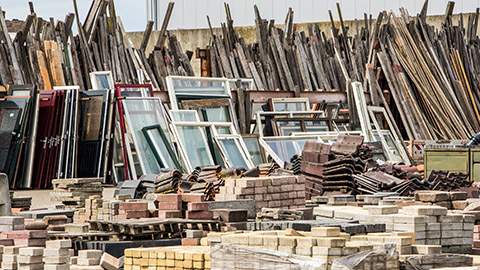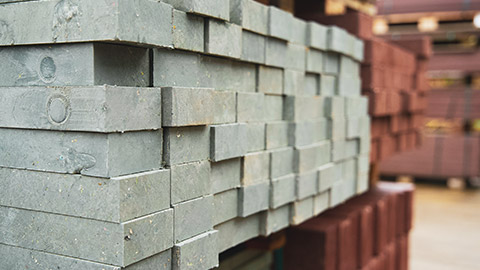In this topic of procurement of materials, we look at good practice guidelines when procuring resources to meet the project's buildability.
Our aim in this module is to:
- Examine features affecting the process of material procurement.
- Associate environmentally sustainable practices to a construction project.
Procurement is a term describing the purchasing process for goods and services.
In the construction industry, material procurement is when the materials you require to construct a building are selected, ordered, invoiced, paid for and delivered to the project site.
Once you have procured, it is your material for use!
Choosing the correct materials for a project requires considerations.
You need to:
- check the product's availability over time
- think about the aesthetic appeal, as well as the related cost
- carry out a material’s life cycle assessment to consider the material's performance
- consider its potential for reuse, recycling, or disposal at the end of its life.
Materials must be used sustainably; as referenced from BRANZ, this means "the present use will not compromise future use by running out or harming the environment at any time".
Selection of material
The purchaser ensures that materials are ordered on time and stock levels are maintained on-site.
If you are selecting material or resources yourself, your main consideration, as referenced from BRANZ, should be to use the following:
- Materials from a renewable or replaceable source.
- Recycled materials where possible.
- Materials that are in plentiful supply.
- Materials with a lower environmental impact across their life cycle.
Product Life Cycle

Product's 'Life Cycle' Considerations
Sourcing
When sourcing or getting hold of the materials, try to keep transport costs and resultant emissions to a minimum. The further away, the greater the emission and transport costs will be, so consider sourcing locally where possible, especially heavy and bulky materials.
The up-front cost of your material should be a consideration along with ongoing life cycle costs, including maintenance, replacement cost, demolition, and disposal.
The Availability
Availability may influence your material selection decisions. Lead-in times must be allowed in case of any delays which could result in the project incurring hold-up costs.
The availability of materials also plays a role in the project's budget. When in doubt, using locally available materials may result in a bigger cut to the budget you have allocated for the construction. The benefits of using locally available materials are reduced transportation costs, labour costs, and the probability of any damage to the materials in its transportation.
Think about Using Reuse and Recycling
If materials on the construction site can be recycled, this will reduce the need for new materials to be brought and produced. Just think about it: the energy required to reconstitute materials is generally much less than required to produce new products.
Whenever you can, reusing materials can help benefit overall costs in general.
The three R's of waste minimisation should be applied to any construction and demolition project to help the environment by reducing landfill strains.
Recapping: Reduce, Reuse and Recover.
Reduce
Reducing practices produces less waste.
This is the most important action any construction project should consider undertaking.
Reuse
Reuse existing building materials wherever possible.
Materials that can be reused after the useful life of the building will reduce the need for new materials to be produced in the future.
The installation and attachment method of a specific material can impact its reusability. For example, when choosing fastening techniques, it is more important to prioritize less intrusive techniques, such as employing screws or bolts instead of adhesive and other permanent methods.
Recover
Recycle or upcycle materials that have reached the end of their useful life wherever possible.
Materials that can be recovered will reduce the need for new materials to be produced and purchased, and the energy required is generally much less than the materials required for new production.
Construction Material Shortage
These basic concepts are becoming much more prevalent in the construction industry today as more and more people become aware of these resources' environmental effects.
Many factors have caused a shortage of construction materials; the following UK website explains some of these shortages happening at the moment with construction materials in and around the UK. Read more here.
After reading the "Home Build UK" website article on construction materials shortage, group the statements to the relevant external factors that could potentially affect construction material costs on your project.
To assist you with deciding what particular materials to purchase, there are building manufacturers' specifications.
These specifications assist builders and designers with the key acceptable construction principles.
This type of documentation guarantees the uniformity of the system, process or product. Sections are established within these documents, which are called their standards.
This helps communication between those involved in the production and the use to carry out practices according to their correct construction methods. Examples include health and safety, protection, and ongoing material quality maintenance.
Specifications
The concept of "specifications" is a way for a builder to ensure consistent quality of their construction.
Whenever a building project is granted, these "specifications" are produced and are an extension of the project's working drawings.
Both working drawings and standards of materials complement each other because they provide written instructions to the builders and all other interested parties involved in the project as to what needs to be built and with what.
The working drawings will show the shape, location, and size of the objects included. Still, the project specifications provide the important details and facts about what is required. These are documented so everyone knows what standard they must adhere to and produce.
Manufacturers' Literature
When deciding on resources, most reputable manufacturers publish their literature on the function, specification, quality, installation and use of their products or materials.
Good manufacturer literature will describe the product, where and how it can be used, how it can be stored, certain installation instructions, and the general warranty offered according to the specific conditions.
When using manufacturers' literature, you should always ensure you are working with the latest version. Working from any out-of-date information can be dangerous and a health and safety risk to you and others around you when using it.
BRANZ provides "good practice guides" that builders can use to ensure the quality and functionality of their material choices during or before a project build. These guides are valuable references for builders to consider.
A link to the available BRANZ good practice guides is here (fees applied).
There are several useful resources that you can purchase out there to help make these material selection assessments for your project.
Careful consideration should be taken with any procurement for the "materials performance".
Referenced by BRANZ, "Some materials give off emissions or allow run-off or leaching of chemicals that can harm the health of building occupants. Adequate ventilation can mitigate some of the effects of gas emissions, but materials should generally be selected to minimise adverse effects to occupants".
The NZ Building Code sets minimum required levels of durability for different building elements and materials, which will be a primary driver for selecting the correct materials for the correct jobs.
An example would be the "Timber Preservation Authority Branding Regulations", which ensure that timber treatment methods are easily defined and that the appropriate product selection is conducted to meet the site standards.
This branding and preservative code with its associated hazard class is important to understand or to be aware of, as it is really up to you to recognise the markings and understand where they can be used.
Looking after the materials you purchase helps increase material performance over time. If we take the basic timber weatherboards on a project, if they are painted every 8–10 years, they can perform well for 60 years plus in New Zealand weather conditions.
An example of this selection process can be found in the following PDF document published by BRANZ: "Timber Treatment: Issue 575" Bulletin, which outlines the requirements for timber durability and preservative options available taken from the main NZS standard 3602:2003.
Read pages 2-4 to familiarise yourself with the terminologies and concepts used to help with product or material selection.

Sustainability in construction requires that builders make conscious choices about resources and how they use them at every stage of a product's life.
According to the free online encyclopaedia Wikipedia, the definition of sustainability is simply "the capacity to endure." So, to be sustainable or to have a low-impact effect on the environment during a typical build, we need to consider the following stages:
The Design
Designers can influence the production processes, the product performances and the product's end-of-life options that result in corresponding landfill waste.
So how can the designers help to be more sustainable?
On the market now, materials like adhesives and insulation are being produced and made with renewable materials or with a majority of recycled content. The design of correct drainage systems can improve its ability to reach its completed performance potential.
Materials
The resources builders select for products, the quantities used, and the methods and techniques used to create projects impact the environment. Just think about the energy or water consumption your project uses daily on-site.
Minimising the number of harmful resources, especially non-biodegradable ones, makes a big difference to the project's sustainability.
Transportation
Transportation occurs regularly, and as we know, these transportation processes consume and emit carbon monoxide. Utilising suppliers local to manufacturing and installation points for these materials creates fewer vehicle emissions on shipment.
Service life
The length of a product's service life has a significant environmental impact. The shorter the lifespan of a product, the more frequent the need for a repeat of the production cycle, resulting in a greater demand for extra resources that put strain on the environment.
End of life
When the point at which the task is no longer fit for its intended purpose, it will need to be disposed of. Most of these demolition products end up overfilling the land fill sites.
Let's Wrap It Up with Will
That's the end of module one. Let's hear a summary of what we've covered so far.
